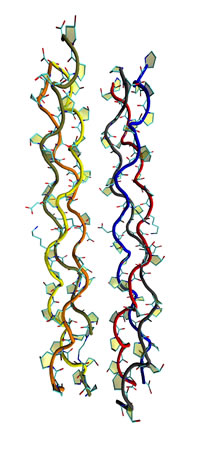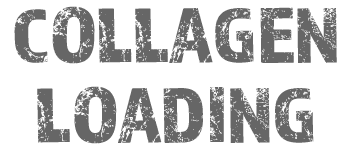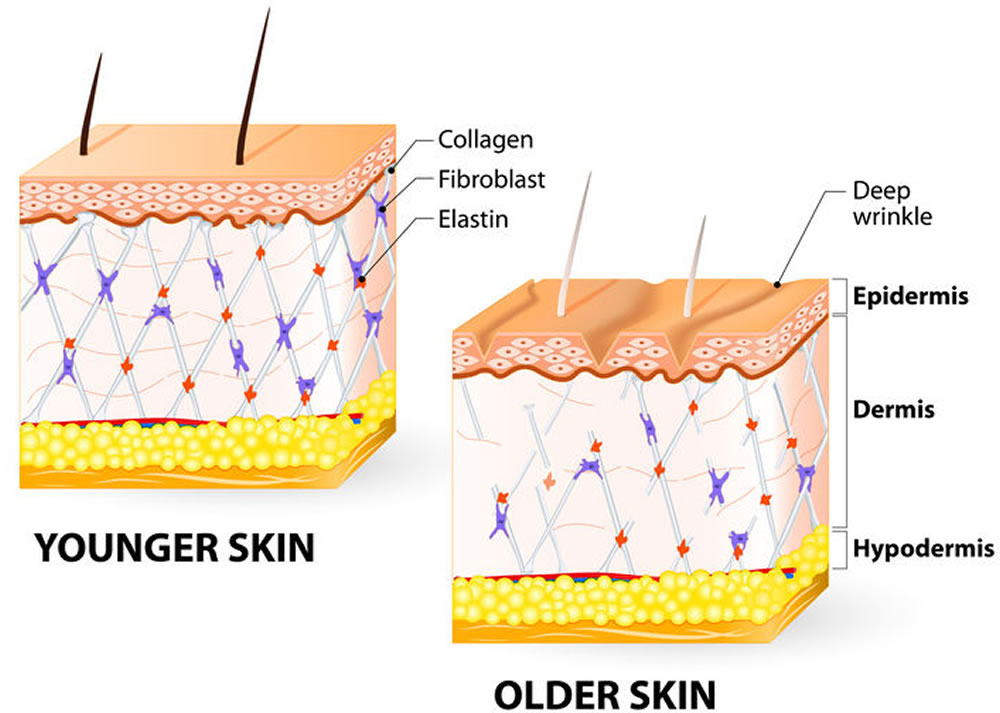Collagen & collagen loading
Collagen is a type of protein found mainly in bones, tendons, ligaments, skin and other connective tissue. Collagen consists of amino acids wound together to form a triple-helix. There are thought to be at least 11 different collagens, coded by a group of about 20 genes. Each of these collagen types have three polypeptide chains, which intertwine into a triple helix. The individual chains typically contain about 1000 amino acids. All collagen types have a high proportion of the amino acids glycine, proline and hydroxyproline. These amino acids can be synthesised into collagen, and collagen can break down into the amino acids.
Collagen is the most abundant protein in the body and has great tensile strength. It is the main component of fascia, cartilage, ligaments, tendons, digestive tract, bone and skin. Along with elastin and soft keratin, it is responsible for skin strength and elasticity and its degradation leads to wrinkles that accompany ageing. You wouldn't run your car without oil, so don't run your body without adding collagen.
Without vitamin C, collagen formation is disrupted. Scurvy is really a process that disrupts the body’s ability to manufacture collagen and connective tissues. Vitamin C deficiency can have a negative effect on collagen levels. We must ensure that out vitamin C levels are always high and have have a generous supply of dietary collagen. Unfortunately, the modern diet of leaner meats (without bones, skin and connective tissues) has reduced our dietary intake of collagen.

Most people have a very low intake of dietary collagen. It's easy and cheap to rectify this via a system of eating and supplementation called collagen loading. You maximise dietary collagen intake in order to give your body a huge boost. It's 100% safe and natural. Collagen loading:-
- Maximise a varied source of food based collagen.
- Take collagen building blocks and
- Supplement with hydrolysed collagen.
- Ensure good levels of the key micro-nutrients.

- Joint health: You can vastly improve joint health and remove many aches and pains by loading with collagen. When we lose collagen, our tendons and ligaments become stiffer and tighter.
- Skin health: Your skin is the window to your inner health, healthy skin is a good indicator of how the rest of your body is feeling. Increasing collagen levels will help your skin look firmer, smoother and help your skin cells keep renew and repair. Increasing collagen with collagen loading will make you look younger. Forget the botox and expensive creams.
- Strong nails, hair and teeth. Collagen loading will have a noticeable impact upon nails and hair. Collagen is found in our teeth and in the connective tissue that keeps our teeth in the jaw. Inside the tooth, collagen aids the mineralisation of calcium and makes our teeth strong. Collagen, Vitamin K2, Boron, calcium, magnesium and vitamin D work synergystically to strengthen teeth and bones.
- Skin damage. Stretch marks, cellulite scarring, acne and dimples can all be reduced with collagen loading.
- Gut health. Your stomach, gut and colon play a vital role in overall health. Collagen forms incredibly strong fibres that make up our GI tract. If you suffer from leaky gut syndrome or irritable bowel syndrome, collagen loading will help soothe and repair your gut’s lining, whilst healing damaged cells.
- Muscle mass and exercise recovery. Joint aches and pain cause people to exercise less and exercise with less intensity. Collagen aids recovery.
- Lung health. Collagens of various types are the major group of proteins in the lung. They are present in all major structures, including airways, blood vessels, fluid filled spaces of the lung, alveolar and membranes. Lung tissue is constantly being broken down and made, so a good intake of collagen is very important. if you are a smoker, then a collagen rich diet is very important.
- Heart health. Deficiencies in vitamin C and subsequently collagen, play a mayor role in heart disease. The walls of our heart arteries are made from collagen and muscle. When lesions and tears occur, it is repaired by new collagen formation. If collagen production in the liver is not working well, our bodies turn to alternative methods to repair the tears, such as the creation of arterial plaque. Proline is needed for tissue repair within the arteries.
Boosting collagen levels with collagen loading
- Most people have a dreadful collagen intake from food.
- Most people are also deficient in key micro-nutrients that support collagen production.
- Collagen production declines with age.
The secret to boosting collagen levels is to use collagen loading. (1) Maximise a varied source of food based collagen (2) Take collagen building blocks and (3) Supplement with hydrolysed collagen and (4) ensure good levels of the key micro-nutrients.
- Vitamin C is vital for collagen production as it is a cofactor for lysyl hydroxylase and prolyl hydroxylase, which stabilise the triple helix of collagen. Extreme vitamin C deficiency results in scurvy, which causes our collagen containing tissues to break down. The RDA for vitamin C is 90mg, but a theraputic dose is 2000mg or higher (taken in 2 does per day). The best fruits for vitamin C are guava, kiwi, pineapple, watermelon, berries and papaya. Although most fruits contain a good amount. If you have bleeding gums and bruise easily, then you might have mild scurvy!
- Bone broth should be your #1 food choice. Generations ago, families used to cook the bones and carcasses of birds and animals to create bone broth. Cooking styles changed and we moved away from eating meat on the bone and meat with skin. Bone broth is rich in minerals that supports bone and join health. Bone broth contains lots of collagen, glutamine, glycine and proline. Bone broth shortens recovery after exercise and helps with sports-related injury. Celebrites are big fans of bone broth, including Kobe Bryant, Gwyneth Paltrow and Elle MacPherson.
- Eat the skin of animals and fish. If you just eat filleted fish or clean cuts of meat, you are throwing away the best parts. Skin contains a huge amount of collagen. Also try and eat meat that is on the bone.
- Hydrolysed collagen powder. This is reduced to small peptides, which can be ingested easily by the body. Hydrolysed collagen has a much smaller molecular weight in comparison to native collagen or gelatin. 90% of hydrolysed collagen is digested and available as small peptides in the blood stream within one hour. Go for grass fed products or quality fish collagen. It's better to take 2 or 3 types as each will have a different amino acid profile.
- Vitamin E (actually a group of 8 compounds called tocopherols) is a fat-soluble antioxidant which scavenges for free-radicals. Vitamin C and vitamin E act synergistically. When UV-activated molecules oxidise cellular components, a chain reaction of polyunsaturated fatty acid oxidation takes place. Vitamin C, glutathione and CoQ10 all also recycle vitamin E in our bodies. The intake of natural vitamin E products helps against collagen cross linking and lipid peroxidation, which are both linked to ageing of the skin. Almonds and sunflower seeds are the best for vitamin E (but almonds contain quite high %PUFAs). Sweet potatoes would really help too. Take a look at eating watermelon, it’s packed with natural antioxidants such as lycopene (huge amounts), vitamin C and citruline. Many studies point to the benefits of taking lycopene with vitamin E. Vitamin E supplements are
- Manganese is required for the activation of prolidase. This is the enzyme that provide the amino acid, proline, for collagen formation in human skin cells. You get manganese from nuts and seeds. It is also stored in the livers of animals. Most multivitamins contain the RDA of around 2-4mg.
- Glycine is essential for many muscle, cognitive and metabolic functions. Glycine accounts for one-third of the amino acids in the collagen molecule, so it's found in high concentrations in the skin, connective tissues and muscle tissue. Glycine can be synthesised in your body from choline, or from other amino acids (threonine or serine). But a high dietary intake is recommended. Glycine can be taken in supplement form, but it’s also plentiful in natural food sources. Pure food grade gelatin or hydrated collagen can be supplemented. The best food source of glycine is bone broth. Most people already get around 2g of glycine daily from their diets, but needs differ a lot depending on someone’s level of activity and state of health. Daily doses of up to 50g are safe. Our recommendation for a healthy dose would be 5g of glycine supplemnet before your first meal (glycine blunts the blood sugar response) and 3g before bed (glycine is great for winding down to a deep sleep).
- L-proline helps heal cartilage and cushion joints. Proline make up about 15 percent of collagen. Proline aids the body in breaking down proteins for use in healthy cells. Along with lysine, proline is a precursor for hydroxyproline and hydroxylysine. The body uses hydroxyproline to make collagen. The best dietary sources of L-lysine are beef, chicken, turkey, fish like tuna, whitebeans, pumpkin seeds and eggs.
- L-arginine improves wound healing. The highest amount of arginine is in turkey breast, with pork and chicken having good amounts too. Fish and animal skins are also rich in arginine. L-arginine is a super supplement, as it helps improve circulation. It follows many metabolic routes within the body, such as converting to the amino acids proline and glutamate. It also serves as a precursor for the synthesis of protein, nitric oxide and urea.
- Whey protein (raw & undenatured) provides the amino acids (cysteine, glycine and glutamate). Whey is considered a “fast” protein, because it is rapidly digested in as little as an hour. Cheap whey protein contains a lot of casein (the curd). Casein is a “slow” protein that is digested over several hours.

There are many types of collagen.
Collagen Types 1 and 3 are both essential for functions and maintenance within skin, muscles, and bones. These types are produced by fibroblasts (the cells in connective tissues) and osteoblasts (cells that make our bones). Over 90 percent of collagen in the body is comprised of Type 1 & 3 Collagen. Proteins in these types include glycine, proline, alanine, and hydroxyproline.
- Type 3 collagen can be found in our artery walls as well as other hollow organs.
- Our skin is 70% type 1 collagen.
- Marine collagen (fish) tends to be rich in type 1.
- Bovine collagen consists of Type 1 and Type 3 collagen (found in the cartilage, bones or hides).
- Chicken collagen is mainly type 2 (often called CCII in supplements).
- Type 2 collagen is only produced by cartilage chondrocytes. Type 2 collagen makes up 50-60% of cartilage protein.
Collagen type 2 is produced by the liquid like filling within the cartilage. Research indicates that by the age of 40, the bodies ability to produce collagen decreases by 25%. By age 60 years, it has decreased by over 50%. Type 2 collagen is vital as we get older, so it's important to have a diet rich in collagen, or it's building blocks.
Hydrolysed collagen peptides are often sold as a supplement. They are made by breaking down the full length chain of amino acids through hydrolysis to form short chain amino acids. Collagen peptides are physically smaller in structure and thus are absorbed more efficiently, it is though the absorption by the body is around 90%.
Hyaluronic acid
Hyaluronic acid is a glycosaminoglycan (GAG), covalently attached to the core proteins within our bodies. They are found in all connective tissues, extracellular matrix and on the surfaces of many cell types. Hyaluronic acid is a clear, gooey substance that is naturally produced by our bodies. The largest amounts of it are found in your skin, connective tissue and eyes. Its main function is to retain water to keep your tissues well lubricated and moist. People take it as a supplement, but it’s also used in topical serums, eye drops and it's also injected. Hyaluronic acid is known as an 'anti-ageing agent' because it promotes youthful looking skin and also helps maintain healthy joints. The best food source of hyaluronic acid is chicken collagen (bones and skin, commercially made from rooster feathers). Chicken bone broth seems to be the most reliable source.
Aloe vera
Aloe vera gel has long been used for healing and soothing wounds. The reason it works to treat cuts and burns is because the aloe vera plant increases collagen production when applied topically or even taken orally. This cell-growth stimulating property can help boost collagen production in your skin. Aloe gel not only increased collagen content of the wound but also changed collagen composition (more type III) and increased the degree of collagen cross linking. Its moisturising effects improves skin integrity, decreases appearance of fine wrinkle and decreases erythema. It also has anti-acne effect.
